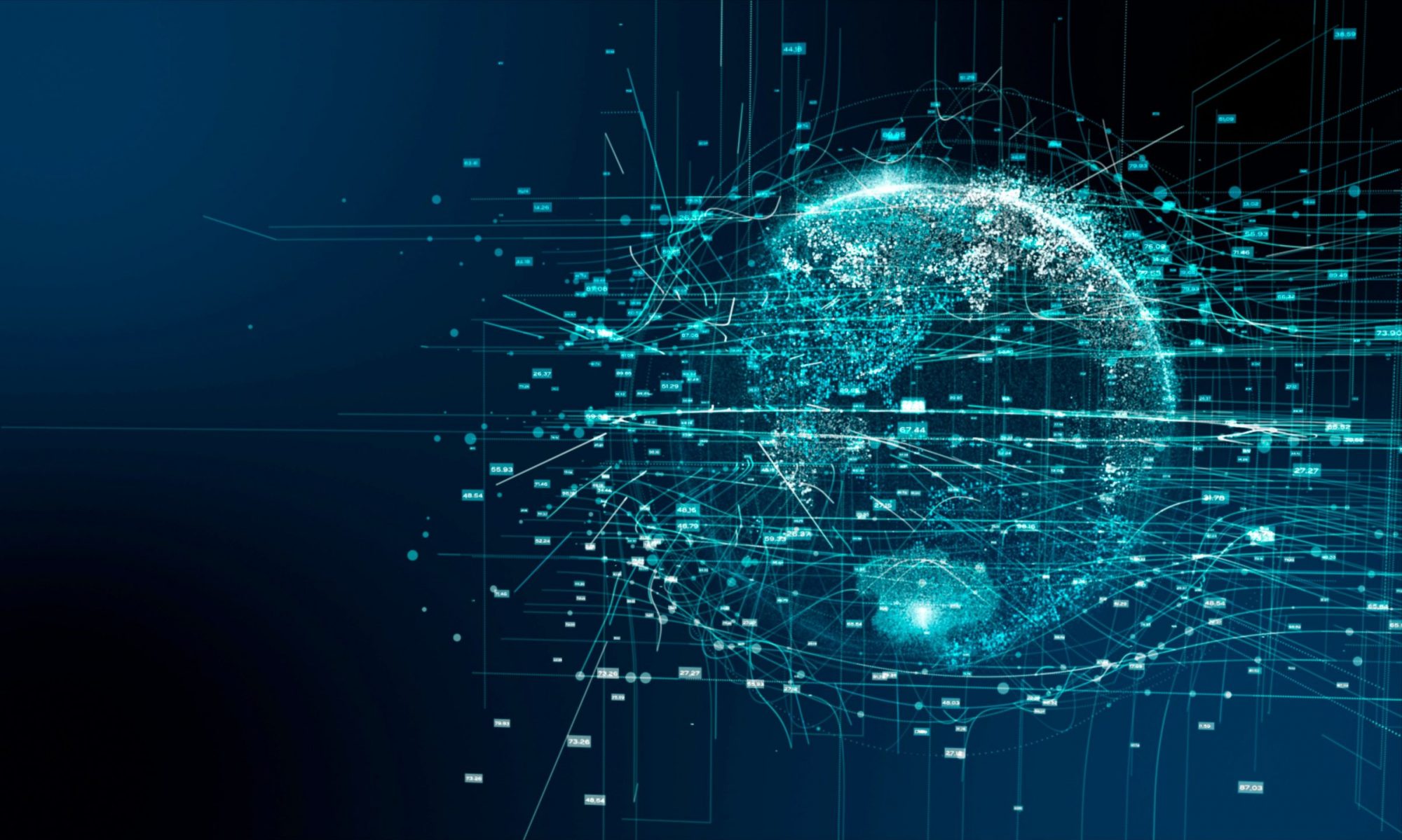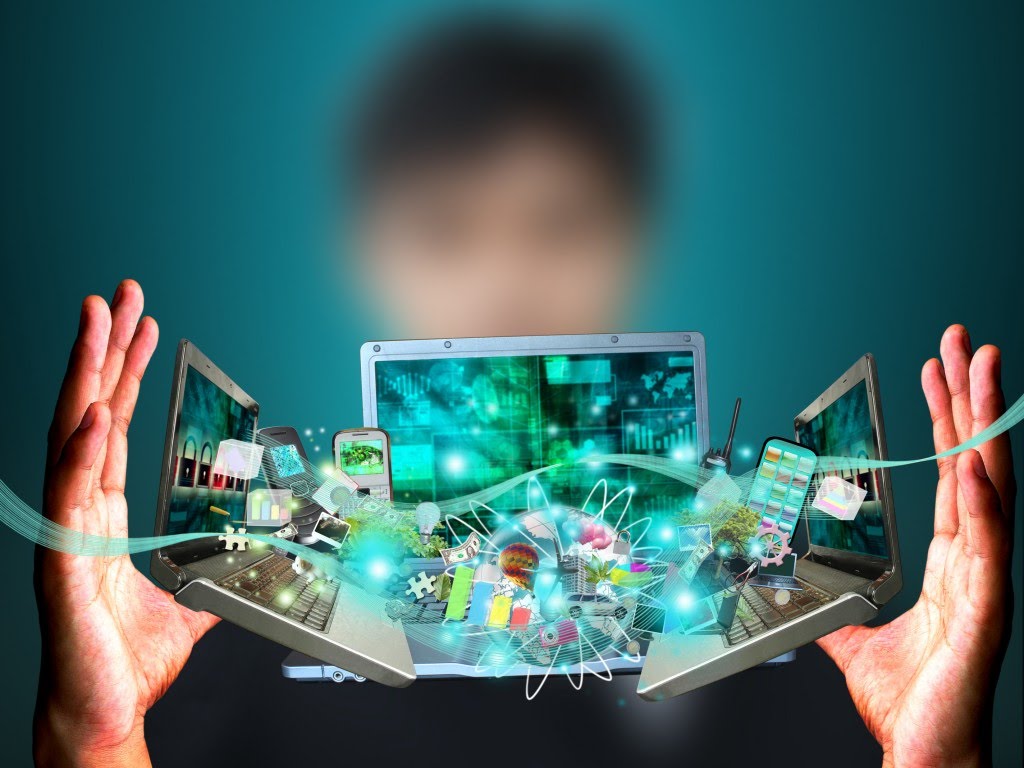Overview
As a group, we wanted to find a technology that has the potential to grow in the future, both near and far. When doing initial research, we realized how prominent robotics was in every industry: automotive, agriculture, manufacturing, military, and medical. We wanted to look at the impacts robotics will have on these industries plus many more, as well as the negative effects that effortlessly come along with robotic disruption. We also knew how heavily robots are impacting and are being impacted by climate change, artificial intelligence, and surveillance capitalism.
Automotive
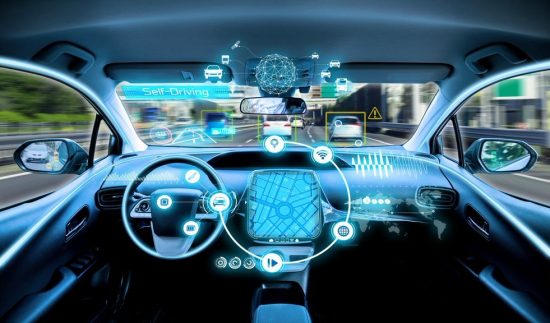 In the automotive industry, we are looking at autonomous vehicles, which are becoming widely popular, and the use of robots in car production. Although Tesla launched the first over-the-air software capabilities in 2012, today we are seeing Waymo, an autonomous driving technology company, start to expand its software and technology capabilities. Right now Waymo operates its fully autonomous vehicles in Chandler, Gilbert, Mesa, and Tempe, Arizona. On November 3rd, 2021, the news was reported that Waymo was starting to map the streets of New York City, to bring their fully autonomous technology to NYC in the future. Unfortunately, NYC is a busy place with people constantly maneuvering the streets, and not all autonomous vehicles have the safety features to make sure pedestrians are safe. While fully autonomous vehicles are up and coming, there is still a long way to go before they are one hundred percent safe and completely in use daily.
In the automotive industry, we are looking at autonomous vehicles, which are becoming widely popular, and the use of robots in car production. Although Tesla launched the first over-the-air software capabilities in 2012, today we are seeing Waymo, an autonomous driving technology company, start to expand its software and technology capabilities. Right now Waymo operates its fully autonomous vehicles in Chandler, Gilbert, Mesa, and Tempe, Arizona. On November 3rd, 2021, the news was reported that Waymo was starting to map the streets of New York City, to bring their fully autonomous technology to NYC in the future. Unfortunately, NYC is a busy place with people constantly maneuvering the streets, and not all autonomous vehicles have the safety features to make sure pedestrians are safe. While fully autonomous vehicles are up and coming, there is still a long way to go before they are one hundred percent safe and completely in use daily.
Agriculture
 Next, agriculturally, society has taken a huge leap to benefit us and the farmers working to produce mass crops. There have been so many technological advances in the past 5 years that have determined the future of agriculture. There are autonomous drones that monitor crops, provide data on soil assessment, fertility, and crop protection. Drones are up and coming in agriculture and not used mainstream… yet. Hyl.io, an agricultural drone maker, predicts that there would be an increase in technology specifically in agriculture in the next few years. From 2019 to 2027 the global agricultural drone market is predicted to grow by 2.05 billion dollars. If this technology is being used globally the number of possibilities for crops and farms are infinite. Robots and the technology they provide allow higher crop productivity, less waste, reduced impact on the natural ecosystem, less runoff of chemicals into rivers and groundwater, and increased worker safety. These are all amazing benefits, but it goes beyond the obvious facts. All the benefits listed, in turn, benefit climate change as well. With robots being used to limit the waste of runoff chemicals those chemicals are not poisoning the planet and crops around it as well as the use of recycling to reduce the need to produce new resources. If we can assist in slowing down the climate change problem by implementing robotic technology in crops, and the technology is projected to increase by 2.05 billion dollars globally, we can see a serious change in the next 10 to 15 years. On the other hand, we must look at the negative impact robots will have on agriculture. The biggest being the old laws that stand in the way of robotic technology progressing. The old regulations that were in place make it impossible to improve the productivity and efficiency of technology on farms. This is where there must be a change, as technology progresses, rules and regulations must follow.
Next, agriculturally, society has taken a huge leap to benefit us and the farmers working to produce mass crops. There have been so many technological advances in the past 5 years that have determined the future of agriculture. There are autonomous drones that monitor crops, provide data on soil assessment, fertility, and crop protection. Drones are up and coming in agriculture and not used mainstream… yet. Hyl.io, an agricultural drone maker, predicts that there would be an increase in technology specifically in agriculture in the next few years. From 2019 to 2027 the global agricultural drone market is predicted to grow by 2.05 billion dollars. If this technology is being used globally the number of possibilities for crops and farms are infinite. Robots and the technology they provide allow higher crop productivity, less waste, reduced impact on the natural ecosystem, less runoff of chemicals into rivers and groundwater, and increased worker safety. These are all amazing benefits, but it goes beyond the obvious facts. All the benefits listed, in turn, benefit climate change as well. With robots being used to limit the waste of runoff chemicals those chemicals are not poisoning the planet and crops around it as well as the use of recycling to reduce the need to produce new resources. If we can assist in slowing down the climate change problem by implementing robotic technology in crops, and the technology is projected to increase by 2.05 billion dollars globally, we can see a serious change in the next 10 to 15 years. On the other hand, we must look at the negative impact robots will have on agriculture. The biggest being the old laws that stand in the way of robotic technology progressing. The old regulations that were in place make it impossible to improve the productivity and efficiency of technology on farms. This is where there must be a change, as technology progresses, rules and regulations must follow.
Manufacturing
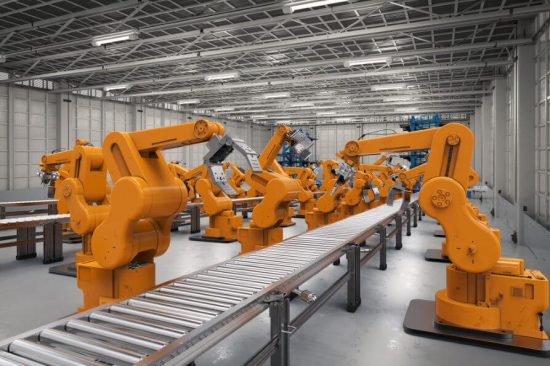 We have also done extensive research done on manufacturing robotic technology, which is nothing new but is becoming more complex and versatile. Rent-A-Robot is a new manufacturing tool used by some companies when low on human workers. Large manufacturing companies are able to rent a robot to take place of a human worker due to labor shortages. The cost alone of robots instead of humans is a no-brainer to replace every human with a robot. Below is a chart of what it looks like to pay for a robotic machine that runs for 24 hours versus the salary of three employees.
We have also done extensive research done on manufacturing robotic technology, which is nothing new but is becoming more complex and versatile. Rent-A-Robot is a new manufacturing tool used by some companies when low on human workers. Large manufacturing companies are able to rent a robot to take place of a human worker due to labor shortages. The cost alone of robots instead of humans is a no-brainer to replace every human with a robot. Below is a chart of what it looks like to pay for a robotic machine that runs for 24 hours versus the salary of three employees.
It is clear why large manufacturing plants choose robotic technology over human capital. Other benefits of robots in manufacturing include efficiency in raw material handling to finished product packing, the ability to program robots to work 24/7 autonomously, programming robots to perform complex functions, invokes competitiveness between large companies, and is extremely cost-effective as previously mentioned. Manufacturing robots also have a huge positive impact on climate change. From the use of robots in manufacturing plants, the robots can monitor industrial sites for emissions of greenhouse gasses. We see an example of this at the Nissan Intelligent Factory, where Nissan has produced a zero-emission production system. Hopefully, they have started a new trend that will turn other auto manufacturers into zero-emission factories in addition to making themselves a zero-emission automotive company. Since this is a relatively new concept, we have not seen enough to depict the future of zero-emission plants, especially because the one Nissan has is in Japan.
Military
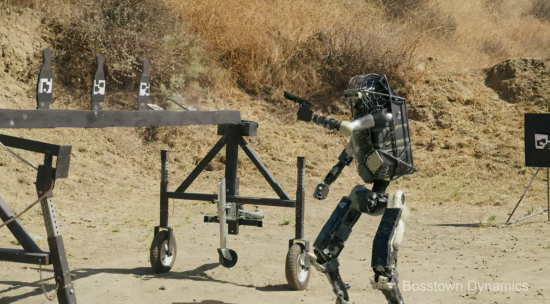 Next, we analyzed the impact of robotics on military technologies. It is first important to note that global military robots are projected to grow by 17,061.63 million by 2030, so most of the global militaries will have advanced their technology if possible in 10 years. In the past year the United States, China, and Russia have developed and tested new military robots, which is a clear indication of how they are looking to advance in the future. The United States Navy uses Unmanned Underwater Vehicles (UUVs), which are drones for underwater surveillance, investigation, and intelligence work. Additionally, quadrupedal robots, or robotic dogs, are being tested after advancements made to them. The gun on the robot itself has a 30x optical zoom, a thermal camera for targeting in the dark, and an effective range of 1,200 meters. These quadrupedal robots are used right now to patrol the Tyndall Air Force Base’s perimeter and to navigate swampy areas that not all humans and vehicles can access. While many people are opposed to weaponized robots because of possible causalities or the robot itself being hacked, there are no US policies in place that prohibit the advancements and use of them. The lack of US policies allows the US military to advance their robotic technology as far as possible until running across a policy problem.
Next, we analyzed the impact of robotics on military technologies. It is first important to note that global military robots are projected to grow by 17,061.63 million by 2030, so most of the global militaries will have advanced their technology if possible in 10 years. In the past year the United States, China, and Russia have developed and tested new military robots, which is a clear indication of how they are looking to advance in the future. The United States Navy uses Unmanned Underwater Vehicles (UUVs), which are drones for underwater surveillance, investigation, and intelligence work. Additionally, quadrupedal robots, or robotic dogs, are being tested after advancements made to them. The gun on the robot itself has a 30x optical zoom, a thermal camera for targeting in the dark, and an effective range of 1,200 meters. These quadrupedal robots are used right now to patrol the Tyndall Air Force Base’s perimeter and to navigate swampy areas that not all humans and vehicles can access. While many people are opposed to weaponized robots because of possible causalities or the robot itself being hacked, there are no US policies in place that prohibit the advancements and use of them. The lack of US policies allows the US military to advance their robotic technology as far as possible until running across a policy problem.
Medical
 Lastly, we researched the effects robotic technology was having on the medical field. There are five major medical robots: the da Vinci surgical robot, the Xenex Germ-Zapping Robot, The PARO Therapeutic Robot, The CyberKnife, and the TUG. The da Vinci surgical robot can perform precise movements during a surgery that is incapable by any human. The Xenex Germ-Zapping Robot is automated and portable and has the ability to disinfect entire hospital rooms in minutes. Next, the PARO Therapeutic Robot provides animal therapy without relying on live animals, this robot is used to support the quality of life after a patient’s surgery or treatment. PARO is linked to reduced stress levels and provides comfort to anxious patients. The CyberKnife is a robotic surgery system that delivers radiation therapy to tumors with sub-millimeter precision. CyberKnife can supply surgeons with the support they need to do the work they cannot do. Lastly, the TUG is an autonomous robot that transfers supplies, meals, and other materials around the hospital. Robotic technology was also used to create companion bots, which are robots that use emotional artificial intelligence to connect with people and comfort them. Hospitals have used them for comforting children when their anxiety levels were high. In the past year, the development of these robots has accelerated because of Covid-19. Since there were visitor restrictions, hospitals had the time and resources to use these companion bots on patients and see if they work. The use of robotics in hospitals is incredible, but there are some downfalls. Robots are costly to put in every hospital, so not all hospitals have full access to them yet, all employees working with the robot must be properly trained, and robots still have the possibility of making mistakes.
Lastly, we researched the effects robotic technology was having on the medical field. There are five major medical robots: the da Vinci surgical robot, the Xenex Germ-Zapping Robot, The PARO Therapeutic Robot, The CyberKnife, and the TUG. The da Vinci surgical robot can perform precise movements during a surgery that is incapable by any human. The Xenex Germ-Zapping Robot is automated and portable and has the ability to disinfect entire hospital rooms in minutes. Next, the PARO Therapeutic Robot provides animal therapy without relying on live animals, this robot is used to support the quality of life after a patient’s surgery or treatment. PARO is linked to reduced stress levels and provides comfort to anxious patients. The CyberKnife is a robotic surgery system that delivers radiation therapy to tumors with sub-millimeter precision. CyberKnife can supply surgeons with the support they need to do the work they cannot do. Lastly, the TUG is an autonomous robot that transfers supplies, meals, and other materials around the hospital. Robotic technology was also used to create companion bots, which are robots that use emotional artificial intelligence to connect with people and comfort them. Hospitals have used them for comforting children when their anxiety levels were high. In the past year, the development of these robots has accelerated because of Covid-19. Since there were visitor restrictions, hospitals had the time and resources to use these companion bots on patients and see if they work. The use of robotics in hospitals is incredible, but there are some downfalls. Robots are costly to put in every hospital, so not all hospitals have full access to them yet, all employees working with the robot must be properly trained, and robots still have the possibility of making mistakes.
Medical use robots are not only in hospitals but can be used for home healthcare as well. Stevie, a robot living in a retirement home in Washington, D.C., has its own room in the assisted living home and is autonomous. Stevie can be activated by saying the words “Hey Stevie” and engaging with the community both socially and physically. Most importantly, Stevie can recognize voice commands and alert staff if a resident is in distress. These robots help staff as well as members if there is an emergency. These robots are so helpful that 60% of the country’s nursing facilities use robots. Although they are extremely useful, robotic technology is not cheap, especially at the advanced level they are at. In the future, and if they are cheaper to produce, medical robotic technology may become more widely available and even covered by insurance. Looking 10 years from now, nursing homes may not be necessary if the elderly can get the same care in the comfort of their own home by a robot. Looking at the advancements already in healthcare, there will be a drastic change to our normal healthcare system soon.
The Social Perspective
The way we see technology has always inspired a sense of awe and fascination as to what the future may bring. Popular views on robotics date back to the opening of The Walt Disney Company’s Tomorrowland in 1955. Here, common people were introduced to the possibilities of robots and where that may lead mankind. Walt Disney, the American entrepreneur, was often referred to as being an obsessive futurist. For example, one of his greatest accomplishments was establishing EPCOT, or the Experimental Prototype Community of Tomorrow, theme park in 1982. Who is better to steer the public perception of robotics than the king of entertainment himself?
However, these grandiose expectations set by the mogul behind the mouse would soon disappoint most into realizing that the concepts of Tomorrowland were closer to science fiction than they were reality. During the same time, the “Grandfather of Robotics” George Devol invented the first industrial robot, Unimate, a hydraulic arm that would perform unskilled labor. After a highly anticipated reveal to Ford Motor Co. alongside American physicist and engineer Joseph Engelberger. It flopped. Nobody understood its purpose nor did anyone see any value in this innovation until about a decade later when competition with Japanese automotive companies spiked. Thus, the American auto industry began integrating Unimate into their production lines. At first, the public backlash was extreme and the workforce strongly resisted. Soon, the chaos settled down and just a decade later would a 1983 study claimed that robotics create more jobs than destroy.
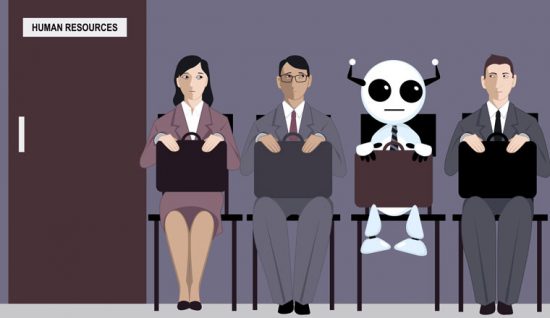 Today, mankind struggles with similar issues. The capabilities of robotics have exceeded many expectations and are beginning to become common in our everyday lives. Yet, some still fear that robots will replace humans in most occupations. Fortunately, as this notion was proclaimed false in 1983, it continues to remain that way to this day. Study after study shows that robotics creates more jobs in the long run than eliminate. In fact, only a small percentage of all occupations are fully automatable. In other words, robotics will push for increased skill sets and more wage competition among middle-class workforces. Most occupations affected by autonomous robots are either unskilled or semiskilled labor, which typically only pays minimum wage. This may be beneficial to the lower class as minimum wages are harming their job prospects, which is something economists were worried about. While the push to replace some workers with robots is still mostly negative, there exists a surge in information pertaining to how robotics may help advance these industries. Despite all the graphs, articles, and videos counterarguing this point, people do not seem convinced. One study shows that the vast majority of U.S. workers expect widespread automation to disrupt the workforce by 2050. Despite this, the same group does not believe their job will be affected by it. Also, the study shows that 76% of American workers think that robots will create income inequality. On top of this, nearly a third of American workers believe it will create more jobs. These statistics are not reassuring.
Today, mankind struggles with similar issues. The capabilities of robotics have exceeded many expectations and are beginning to become common in our everyday lives. Yet, some still fear that robots will replace humans in most occupations. Fortunately, as this notion was proclaimed false in 1983, it continues to remain that way to this day. Study after study shows that robotics creates more jobs in the long run than eliminate. In fact, only a small percentage of all occupations are fully automatable. In other words, robotics will push for increased skill sets and more wage competition among middle-class workforces. Most occupations affected by autonomous robots are either unskilled or semiskilled labor, which typically only pays minimum wage. This may be beneficial to the lower class as minimum wages are harming their job prospects, which is something economists were worried about. While the push to replace some workers with robots is still mostly negative, there exists a surge in information pertaining to how robotics may help advance these industries. Despite all the graphs, articles, and videos counterarguing this point, people do not seem convinced. One study shows that the vast majority of U.S. workers expect widespread automation to disrupt the workforce by 2050. Despite this, the same group does not believe their job will be affected by it. Also, the study shows that 76% of American workers think that robots will create income inequality. On top of this, nearly a third of American workers believe it will create more jobs. These statistics are not reassuring.
It may take a while before people begin to see exactly what robotics has to offer for mankind. We no longer see the streets crowded with tempered employees protesting the assembly lines at Tesla, despite robotic machines piecing their electric vehicles together and Elon Musk saying that is an issue. Nowadays, it is speculated that the top industries to look out for automation accelerating in are retail, agriculture, transportation, manufacturing, and accommodations and food. Not to mention the humanoid robots many imagine AI inhabiting to perform functions, conflicting studies go back-and-forth between stating people’s preferences; some prefer human-like features on robots and others do not. The good news is that this has an easy solution: adjustable features. Commonly used in robotics concerned with the mental health of its patients, robots may have features ranging from zoomorphic to humanoid to mechanistic to cartoon-like and so on. Tailor the look of the robot to the needs of its user or owner. This satisfies the desires of most treated patients, including children, but not all. There will always be forces pressing against the use of robotics in our lives.
The Legal Perspective
With certain groups and people pushing against the use of robotics, many legal issues soon followed. Just recently, a class-action lawsuit was filed against Amazon.com for wiretapping via their Amazon Echo smart speaker. The plaintiff alleges that the smart speaker will record the conversation, despite there never being mention of the “trigger” word which activates it to listen and record. Even worse, the recordings are alleged to have been stored by Amazon and undisclosed as to whether it is shared with third parties or not. Problems like these emerge with technologies that the public quickly embraces without much forethought. Suppose we were to spare a moment or two to think if putting devices like these in our homes are truly beneficial. Do they do more harm than good? While the Amazon Echo provides various skills, what are its cons? There are over 100,000,000 Amazon Alexa devices enabled in homes across the globe and in these homes, these devices have been gathering information on us, our family, our friends, and anyone else that comes into contact with it. These devices record, upload, store, and analyze clips of our speech on a daily basis. This is clearly a crisis for privacy.
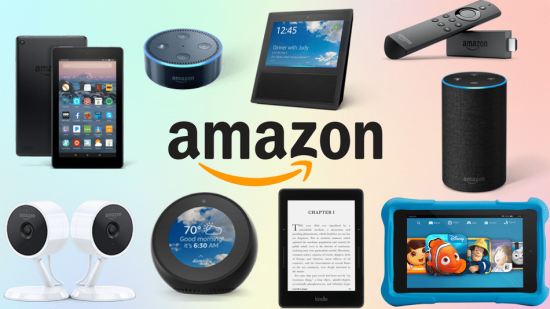 The Amazon Echo is not the first to evolve into a threat to privacy concerns, either. This has been going on for decades, centuries even. The difference is that, nowadays, the information can be permanently kept and used as data to help grow their businesses. Hence, why companies such as Google or Amazon grow so rapidly over time. It is not shocking news that there exists plenty of legal battles being fought over Google, but most are either dismissed by the courts or handled through arbitration. This leaves advocates for digital privacy empty-handed and hopeless. Robotics, unfortunately, are mostly aiding the fight against privacy. For example, Amazon released several generations of the Amazon Echo. Additionally, they released a smaller, more affordable version called the Amazon Echo Dot. The list goes on to showcase their Echo Look, Echo Show, Echo Frames, Echo Buds, Echo Auto, Ring Doorbell, and so on. Consumers of these products live in an Amazon dystopia, constantly being watched, and listened to. Worse of all is the newest Amazon Astro, a robot that quite literally patrols your home while recording both audio and video.
The Amazon Echo is not the first to evolve into a threat to privacy concerns, either. This has been going on for decades, centuries even. The difference is that, nowadays, the information can be permanently kept and used as data to help grow their businesses. Hence, why companies such as Google or Amazon grow so rapidly over time. It is not shocking news that there exists plenty of legal battles being fought over Google, but most are either dismissed by the courts or handled through arbitration. This leaves advocates for digital privacy empty-handed and hopeless. Robotics, unfortunately, are mostly aiding the fight against privacy. For example, Amazon released several generations of the Amazon Echo. Additionally, they released a smaller, more affordable version called the Amazon Echo Dot. The list goes on to showcase their Echo Look, Echo Show, Echo Frames, Echo Buds, Echo Auto, Ring Doorbell, and so on. Consumers of these products live in an Amazon dystopia, constantly being watched, and listened to. Worse of all is the newest Amazon Astro, a robot that quite literally patrols your home while recording both audio and video.
With so many different, ranging devices keeping their eyes on us, how can we apply one universal law to rule them all? The short and simple answer is we can’t. Even the term ‘robot’ is used ambiguously to describe a spectrum of devices. Ergo, it is vital that with each emerging technological innovation, a proper amount of testing is conducted by a third party, after first classifying the device into a general category. Afterward, one must consider the first, second, and third-order effects of this device once put into use. Use this foresight to project its implications and enforce policies surrounding these concerns. No matter how thorough the research might be, it is unlikely that everything will be sufficiently covered until the device becomes of practical use. In this case, it is important to keep our members of Congress informed and up-to-date so that when the time comes, they know how to appropriately treat the case. This is easier said than done, unfortunately, but it remains the people’s responsibility to help ensure their privacy. As for civil cases, the main concern is a liability. Nobody wants a multi-million-dollar robot to be accidentally destroyed, so insurance agencies might have to begin enacting separate policies for both physical and intellectual property. Or, for example, say a police robot sniper accidentally misfires and injures or kills an innocent victim; these are worst-case scenarios that must be prepared for. As for the privacy of the consumer, standardization and agencies revolving around regulating robotics might have to become commonplace to keep the companies in line. Some organizations are even arguing for the government to impose restrictions and limitations on the extent to which robotics may have on the lives of the consumers, but most efforts prove to be futile and in vain. Regardless, the ongoing war against unfair robotic interference in our lives rages on in the courtrooms around the world.
The Ethical Perspective
Billions of people are anticipated to be affected by robotics soon and many have excitedly embraced this dramatic shift, but how do the people know when they have gone too far? When does the robot become an inhibitor of human development, opposed to an accelerant? Where should the lines be drawn?
Many ethical concerns with robotics go together with the social and legal issues covered. Privacy concerns. Police and military robots. AI mistakes. Regulation and robot rights. Job displacement. Then, there are newly introduced ones. Misinformation. Cybersecurity. Algorithm bias. Superintelligence.
 Returning to privacy, people are always worried about topics such as constant surveillance. This promotes the idea of the Hawthorne effect, which is when someone acts or behaves differently because they know they are being watched. This is true for robotic surveillance, as well. Books, movies, articles, social media posts, have all been made on the lack of feeling safe when around robotics, especially relating to the invasion of their personal information. About six out of every ten Americans believe it is impossible to go about their day without their privacy being stolen or used, one study shows. Not only does this lead to sporadic and odd behavior patterns, but a lack of privacy also causes elevated stress levels and increasing severity of mental health issues. Sadly, companies already use robotics to scan audio recordings to spot signs of depression, even when the intentions of the company are to put them in touch with counseling services. People prefer to be safe and secure, which means not being watched or listened to by robotic devices in the comfort of their own homes.
Returning to privacy, people are always worried about topics such as constant surveillance. This promotes the idea of the Hawthorne effect, which is when someone acts or behaves differently because they know they are being watched. This is true for robotic surveillance, as well. Books, movies, articles, social media posts, have all been made on the lack of feeling safe when around robotics, especially relating to the invasion of their personal information. About six out of every ten Americans believe it is impossible to go about their day without their privacy being stolen or used, one study shows. Not only does this lead to sporadic and odd behavior patterns, but a lack of privacy also causes elevated stress levels and increasing severity of mental health issues. Sadly, companies already use robotics to scan audio recordings to spot signs of depression, even when the intentions of the company are to put them in touch with counseling services. People prefer to be safe and secure, which means not being watched or listened to by robotic devices in the comfort of their own homes.
A newer concept is incorporating robotic dogs into police departments. Some even have snipers. Clearly, with movements such as Black Lives Matter and ACAB gaining popularity, the public reception of this has not been ideal. In fact, they have already forced the NYPD to retire police dogs due to strongly disliking its appearance and fearing for police brutality. On the bright side, it would create jobs to have men and women operate certain aspects of the machinery. On the other hand, war is speculated to grow with the use of robots. Naval ships have already been shown to be fully automatable, hence future wars are expected to use fewer and fewer people over time. This may seem positive, but the heavy reliance on robots to bid human wars also means increased production of machines capable of mass destruction which is less-than-great. Couple this with an AI mishap and an automatable nuclear launch center could accidentally fire an ICBM or nuclear warhead. Now, some groups worry mankind will cease to exist due to a technical glitch. There will have to be plenty of regulations dictating how to exercise the use and functionality of these robots.
Another major concern is cybersecurity. In the 2016 presidential election, British political consulting firm Cambridge Analytica stole over 50 million Facebook accounts and used them to spread misinformation regarding the election in favor of the 45th President of the United States, Donald Trump. This proves that robotics may influence and impact entire countries, let alone individuals and sizable groups. Misinformation may be easily disregarded, but when it is published on a mass scale, it is less likely to be brushed off. Thus, manipulation of the election serves as a prime example of the extent that misuse of robotics may go. There are many similar examples, each pointing to the same result that robotics can and have been used for poor intentions. On top of this, consumers must consider the algorithmic bias of those who design and code the robotics that people use to prevent discrimination. These are only a few of the main ethical concerns robotics have provoked. With each new innovation, there sprout multiple questions about whether or not it is going to be used ethically, who it affects, how severe is the impact, and what benefit does it bring to mankind.
The Cultural Perspective
In terms of the cultural implications that robots will have, there are many individual and household implications that need to be considered. Not only will robots offer easy, seamless, and convenient methods to interact and engage with society, but they are cost-efficient and environmentally friendly.
 Robotics will infiltrate homes through the oncoming wave of home automation that society is currently experiencing. As robots become more affordable for the household and the autonomous technology robots rely on becomes more dependable, home automation will become a household staple and steeple of global culture. A technology that will lead to this advancement is the Internet of Robotic Things, which will allow robot systems to monitor events, combine data from various sources, use artificial intelligence to determine the best course of action, and manipulate objects in the physical realm. When integrating robotics into the Internet of Things, robots can be utilized within the physical world to accomplish tasks. In a household setting, robots will become responsible for managing the home. This includes stocking the pantry, cleaning the home, securing the home, ordering home items when necessary, cooking meals in the kitchen, and controlling simple functions such as temperature and locking doors. While there are major privacy concerns with a system like this, time over time humans will select convenience in lieu of privacy violations. Examples of this are the tracking and data selling that occurs with social media apps and Amazon’s listening on the echo device. Users are aware of these factors and even signs of them in the terms and conditions. Yet, users believe the violation of their privacy is worth the convenience these products can bring. I would predict that this same outcome would present itself in the future of home automation.
Robotics will infiltrate homes through the oncoming wave of home automation that society is currently experiencing. As robots become more affordable for the household and the autonomous technology robots rely on becomes more dependable, home automation will become a household staple and steeple of global culture. A technology that will lead to this advancement is the Internet of Robotic Things, which will allow robot systems to monitor events, combine data from various sources, use artificial intelligence to determine the best course of action, and manipulate objects in the physical realm. When integrating robotics into the Internet of Things, robots can be utilized within the physical world to accomplish tasks. In a household setting, robots will become responsible for managing the home. This includes stocking the pantry, cleaning the home, securing the home, ordering home items when necessary, cooking meals in the kitchen, and controlling simple functions such as temperature and locking doors. While there are major privacy concerns with a system like this, time over time humans will select convenience in lieu of privacy violations. Examples of this are the tracking and data selling that occurs with social media apps and Amazon’s listening on the echo device. Users are aware of these factors and even signs of them in the terms and conditions. Yet, users believe the violation of their privacy is worth the convenience these products can bring. I would predict that this same outcome would present itself in the future of home automation.
Additionally, robots will be responsible for controlling many of the ways society communicates with each other. Most humans spend most of their day responding to emails, texts, and meeting requests. In the future, almost all individuals will have a robot assistant software that will be able to respond on behalf of themselves. These robots, thanks to emotional AI, will have the ability to adapt your tone and nuances when communicating with others. Again, while the use of software like this presents a major privacy issue, many individuals will willingly consent to it because of the convenience it provides.
Another cultural shift that will be witnessed is the rearrangement of the education system. There will be major changes in the curriculum imposed in schools and the way the material is taught. Robots will begin to be implemented into the classrooms as instructors—this has already been seen in North Korea, where robots support the work of human teachers. Additionally, the material being taught in classroom settings will begin to adapt to what is relevant for the future of society and where jobs will be for the next generation. Many of the future jobs will require higher skills, and schools will start to implement these skills into the curriculum of middle school and high school. It is possible that some robotics jobs will be taught at trade and vocational schools through programs that last a year or less, while other jobs will need advanced knowledge about coding and system software.
The largest cultural shift will have to do with the implications of surveillance capitalism that comes along with the widespread use of robots. Since robotics software will be utilized to analyze footage from street cameras, drone cameras, surveillance robots, and any other footage it can find. This means the analysis of this footage could result in judicial implications, such as arrests being made, or culprits being caught. However, there is a racial bias that skews the reliability of robots. It will be important to remedy this using emotional intelligence as robots are infused with artificial intelligence and not simply big data that has skewed correlations.
The Political Perspective
Robots will have many indirect and direct political implications. For example, in the future, robots will become the main platform item for many politicians. Instead of abortions and gun control, politicians could be debating the uses of robots in the home or robots in the economy. Another popular way this will emerge is instead of cries to tax the rich, there will be politicians and activists demanding to tax the robots to equalize the fact that they take many jobs from humans who could be completing them. Bill Gates has already begun the argument that the best way to slow down the speed of automation is the implement the robot tax. He claims this will help to preserve jobs for the elderly and people with disabilities who could easily be displaced without other job alternatives.
It is important that proper regulations for robotics are identified and properly enforced as this future rapidly approaches society. The regulations could be as simple as making room on the sidewalk for delivery robots or formally declaring different altitudes for autonomous robot drones to fly in. However, the regulations could also be as complex as limiting the function of robotic artificial intelligence to protect humans from being controlled and implementing basic standards to prevent companies from using robotics technology to surveil customers. As far as regulations go for these topics, there are virtually none. Although as technologies further develop and firmly plant themselves in politicians’ faces, they will be unable to ignore the developments in technological fields and will be forced to develop policies to control these developments.
 Additionally, robots have the power to change the way we vote. iSideWith.com provides a variety of questions aimed at identifying which candidate a citizen’s views most likely align with. By using this survey combined with the platform’s robotics-infused AI, which over 52 million citizens utilized in 2019, allows typically overlooked candidates, such as third-party candidates, to gain more of a voice. However, the future of this is terrifying. In a society where voters are becoming increasingly lazy and unwilling to perform their own research, surveys such as this could legitimately be informing citizens’ points of view. Additionally, as the power of artificial intelligence increases and robotic technology begins to develop its own opinions, it is possible that programs like this could be overridden by the robot’s intelligence. If not overridden by the robot, it is possible that a hacker could infiltrate the system and persuade unknowing victims to vote for candidates whose values do not align with their own.
Additionally, robots have the power to change the way we vote. iSideWith.com provides a variety of questions aimed at identifying which candidate a citizen’s views most likely align with. By using this survey combined with the platform’s robotics-infused AI, which over 52 million citizens utilized in 2019, allows typically overlooked candidates, such as third-party candidates, to gain more of a voice. However, the future of this is terrifying. In a society where voters are becoming increasingly lazy and unwilling to perform their own research, surveys such as this could legitimately be informing citizens’ points of view. Additionally, as the power of artificial intelligence increases and robotic technology begins to develop its own opinions, it is possible that programs like this could be overridden by the robot’s intelligence. If not overridden by the robot, it is possible that a hacker could infiltrate the system and persuade unknowing victims to vote for candidates whose values do not align with their own.
Adding to the previous concepts, as robots begin to think for themselves and become prominent in households across the world, a future where robots become the main political voice is potentially possible. There have been growing trends of declining trust in politicians in western societies. Robots, especially as their emotional intelligence is developed and improved upon, can become a voice of reason. Robots will have the ability to process the multitude of data extracted from different demographics in seconds, which can inform all decisions that are made. While the idea of a robot leading seems bizarre, there is a future where robots will be used to help inform human presidents of decision alternatives and the negatives associated with certain decisions.
Time Cone Strategy
Using the time cone strategy as a futurist framework for strategic planning, the future can be plotted out in 1 year, 2-5 years, 5-10 years, and 10 years plus increments. In the first year, the timeline is used to track the tactical implications of the limited data, evidence, and certainty that exists have at this state. In terms of robotics, the tactical state represents the different technologies that are being observed at this moment. This is the emergence of different robotic technologies, such as education robots, household robots, surveillance robots, war robots, etc., etc. As the next step of strategic planning emerges, the observed technologies are then transformed into various trends that are developing in society. For robotics, this could be the trends of convenience, reducing the carbon footprint, becoming cost-efficient, and ensuring quality standards are met. These trends identified in the strategic planning stage are then translated into tangible actions that individuals or organizations can focus on. As the vision phase of the time cone approaches, the strategic planning is then adapted into a vision. This vision enters the mainstream and will take place in the form of robotic home automation systems, leisure robots, fully automated factories, agriculture produced by robots, and cars driven by robotic AI technology. As this vision begins to take form, the full picture of systems-level disruption and evolution can be viewed. This is where the key, fundamental aspects of society that will be changed are identified. For robotics, this will mainly occur in the workforce and the education system as future generations will require a completely different level of skills to enter the workforce since robots will remove many of the low-skilled jobs that are currently options for humans.
Axes of Uncertainty
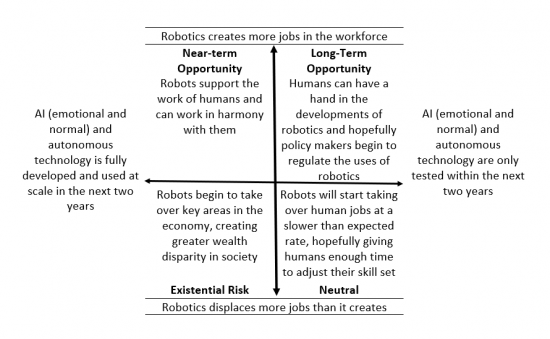
S-SWOT Analysis
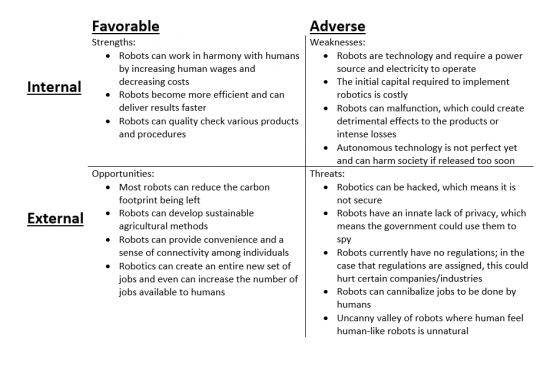
Relation to Other Topics
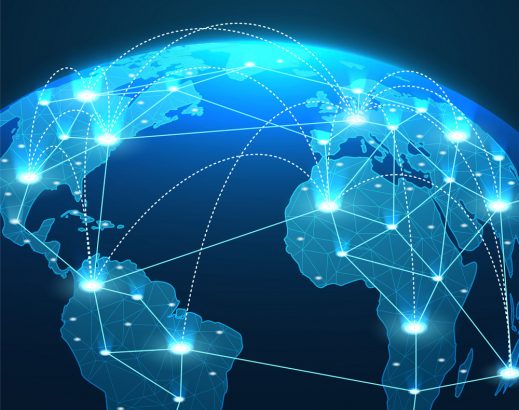
The topics brought researched and addressed through our class this semester is the following: Emotional AI, synthetic biology, climate change, surveillance capitalism, and robotics. All these topics have technology that is growing at an increasingly accelerating rate. Understanding any one of these topics means looking into at least one of the other listed topics. Additionally, the more we understand what technologies and futures exist, the more we can understand what solutions exist. Like David Epstein says in Range, problem-solving skills in one area can be applied to other areas (sometimes in an extremely successful manner). For example, the deep-rooted issue of climate change has the potential to be addressed through a combined approach of robotics and synthetic biology, where robotics can detect and minimize carbon emissions and synthetic biology can help the planet come to life again. In terms of robots not having the capacity to think or problem solve with consideration to ethics, emotional AI provides a solution to this problem. Emotional AI has the power to give robots a conscience, to understand the impact of what their decisions can do. In terms of surveillance capitalism, robots or robotics software can act as the vessel (or trojan horse) that much of this surveillance occurs. Ultimately, it is important to understand that while each group focused on a singular emerging trend, all of the trends are interrelated and dependent on one another.
